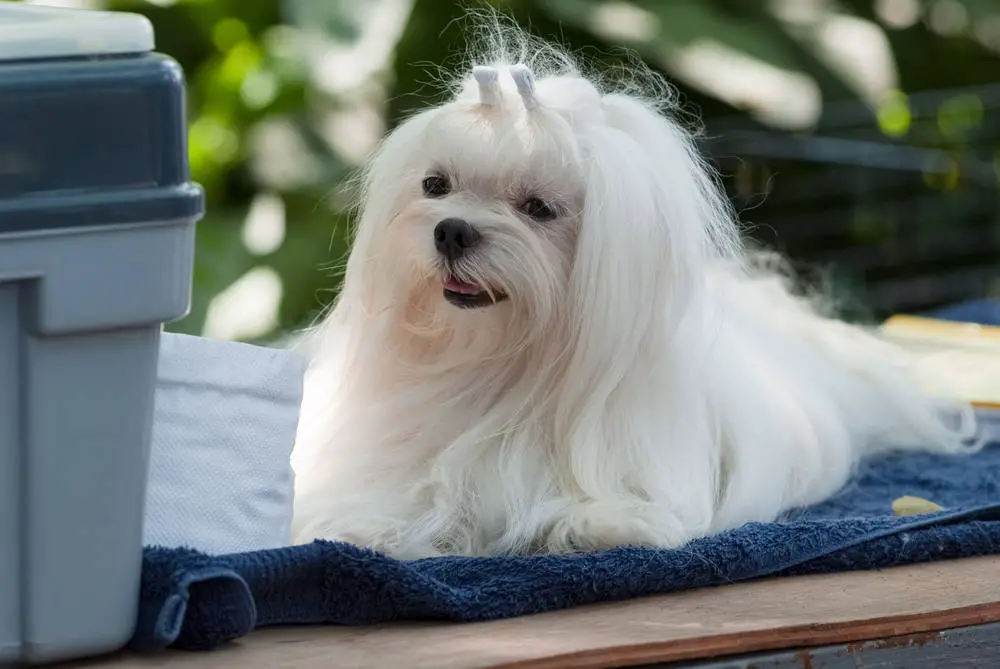 The Maltese are a gentle, charming and playful breed of lap dogs. It’s a very tempting breed if you’re looking for a snuggle companion.
The Maltese are a gentle, charming and playful breed of lap dogs. It’s a very tempting breed if you’re looking for a snuggle companion.
They are believed to have originated in Italy’s Malta which is somewhat known for its sophistication. So, it is kind of fitting that royalty love these dogs and the dogs love attention.
One of the most common questions everyone who wants to be a dog parent asks is how much does the dog breed of their choice shed? And with Maltese dogs, that’s an important one to ask.
To Shed or Not to Shed
That’s a nice Shakespearean twist but in all seriousness, shedding is not a decision you can make no matter the breed of the dog. The best you can do is monitor and manage the amount of shedding.
Maltese dogs are hypoallergenic, meaning they are not likely to have an allergic reaction. But the shedding is not dependent on allergies alone.
There are many other reasons. And despite being a hypoallergenic breed, some Maltese dogs shed quite a bit.
So prospective owners should prepare themselves for some grooming and cleaning activity. Truth is, almost all dogs shed to a certain extent, unless, you know, they are hairless.
What Happens and Why?
Maltese dogs shed and grow the fur back because that is how they maintain their body temperature with changing seasons. Which means, they will shed more during the spring season in preparation for warmer weather in the summer.
There are two types of coats in dogs—single coat and double coat. Maltese dogs fall in the former category and do not have an undercoat. But individual shedding depends on the kind of grooming and maintenance they are privy to.
This is why some Maltese parents complain of excessive shedding while some others face no such problem. And of course, it depends on the climate.
If you live in regions that experience colder climates, your dog might keep its fur on for warmth when compared to your counterparts in the warmer parts of the world.
Is There a Pattern to This Shedding?
That is an excellent question. And yes, there is a pattern. With most dogs, the growing and shedding of fur takes place in four stages.
Anagen Stage
This is the initial stage. It is the beginning of the growth of the first fur on your puppy’s skin.
By the time your Maltese finishes this stage, it will have fully grown hair as dictated by its genes.
Catagen Stage
Once the fur is fully grown, the transition stage begins. This is when the fur stops growing and starts to detach from the surface of its skin.
And hence, begins the trouble for you. This is when the natural course of shedding starts.
Telogen Stage
This is the next step called the resting stage when the shedding has almost stopped but new fur isn’t growing back just yet. You might want to enjoy it but it often doesn’t last that long.
Exogen Stage
This is the final stage when you begin to see the new fur that is growing back on your dog’s skin. From this, your dog quickly goes back to the anagen stage when the fur starts growing back in full swing.
Usually, the growth of fur takes a lot more time than shedding. All hypoallergenic dogs are typically low shedders.
But remember that it really depends on how often you brush its fur and groom the dog.
Related: Why Do Maltese Lick So Much?
How to Care for Their Coat?
Maltese dogs are adorable and that look doesn’t come for free. They are good-looking dogs when their eyes, ears, teeth and coat get that special attention they deserve (although all dogs deserve love and attention).
Their coat is gloriously long and white. It needs to be brushed and combed to the skin on a daily basis. This helps avoid matting and tangles.
They need to be bathed regularly with special attention to conditioning the coat. This keeps them fresh and healthy. Regularly here means once every two weeks.
It is also important to clean the hair around their eyes to keep them from staining. They also grow fur in their ears which should be trimmed often and the ears should be checked for wax.
Side tip: Maltese dogs are prone to dental issues. So, a good rule of thumb is to brush their teeth along with the coat.
How Do I Groom My Maltese?
This is an important step in the health of your little pup. Brushing the fur of your Maltese dog will not only remove tangles and knots but also remove any debris stuck on the fur.
Debris is more common among dogs that tend to play outdoors. Ideally, take a pin brush to its fur brushed two to three times a week.
But depending on the hair growth phase, some dog parents like to do it every day just to make sure the fur(niture) is clean.
But remember that bathing them too often might leave them irritable due to dry skin. So twice a month is good.
How Do I Style My Maltese?
This is not a difficult choice at all. The advantage with that glamorous long hair is that you can go any which way.
You can give your Maltese dog a puppy cut, which is the coat clipped to the same length throughout. Whether your dog has straight or wavy hair, this look suits the Maltese.
The puppy cut is great especially on the face because these dogs have some priceless expressions and you get to see them all. It also means you get to take them to the groomers once a month and avoid the perils of excessive shedding because the length of the hair doesn’t get that far, to begin with.
It also means that washing and drying their coat at home is easier if they go out and get dirty.
But if you want a show coat, Maltese dogs are kind of built for that. They have the ability to grow a long and silky coat which is perfect to be put on display.
You will need to put some effort but it is worth the trouble with this breed. You might also want to put in some buffer time when you take this charmer for a walk because you will be stopped by passersby, a lot.
But if you enjoy putting in that effort, a few hours over the weekends is all the time you need. Make sure you check your dog’s reaction to the maintenance.
If your puppy resists your attempts each time you style the coat, you might want to give up on your preferences and do what makes the little guy happy. But if not, you get to tie a top knot and buy accessories like bowties and bling it up.
In Conclusion
So to answer your question, the Maltese are hypoallergenic but do shed in the technical sense of the word. Those in warmer climates might see more shedding because the dogs do it to balance their body temperature.
They shed more in the spring season than the rest of the year. If your dog is breaking these patterns you might want to pay extra attention.
Their fur is long and silky so it needs to be brushed 2-3 times a week. Some do it more often because of their own preferences and climatic changes.
They need to be bathed about twice a month and be taken to the groomers for overall cleaning around the same frequency.
And whether you keep their hair long or short, they promise to always look pretty for you.

